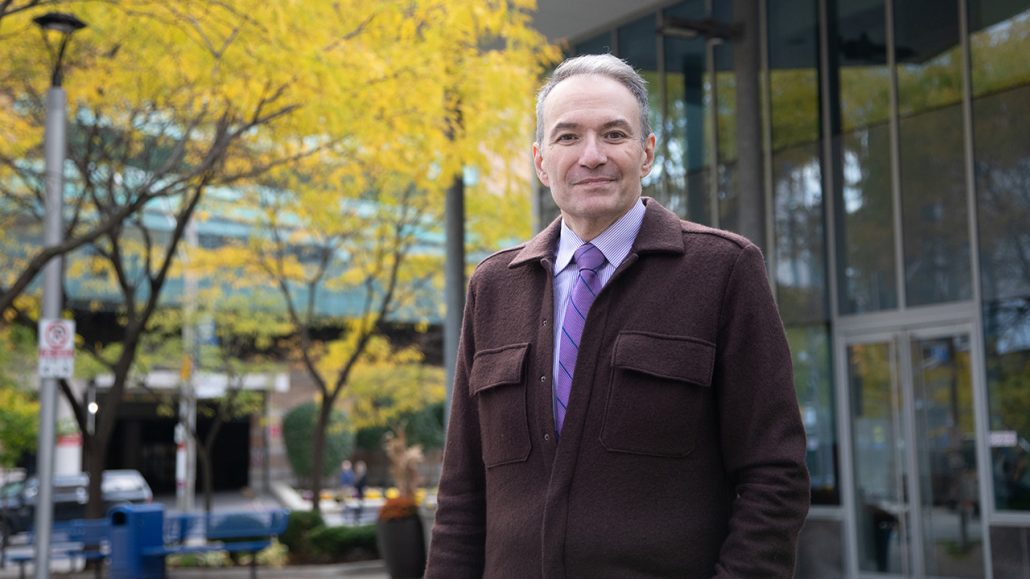

Photo by Daria Perevezentsev
A partnership between the city, medical community and United Way is prescribing a new way to treat homelessness
Homelessness is a complex issue that impacts society’s most marginalized populations. An upcoming initiative in Toronto is taking a collaborative approach to create housing for the people who need it the most.
It started in 2019 with the University Health Network (UHN), where CEO Kevin Smith sat down with his team to better understand how its emergency services were being used in the city.
“We have a small number of people who are very frequently in emergency rooms,” said Smith, who explained that just 230 people accounted for 15,000 visits in one year alone. “It’s unlikely that they’re here for true medical, acute needs. It’s because they had nowhere else to go.”
At the same time, Smith, along with Dr. Andrew Boozary, who is the executive director of population health and social medicine at UHN, considered the non-medical factors that influence health outcomes and recognized housing as a key part of health improvement.
The result was that the UHN set out to create the Social Medicine Initiative (SMI) — a concept inspired by Canada’s former Minister of Health and Welfare Marc Lalonde, who in the 1970s had a belief that ill patients should also be prescribed a place to live as part of their care.
The UHN initiative will consist of the construction of a building in Toronto’s Parkdale neighbourhood featuring 51 individual 250-square-foot residences for unhoused people with chronic, complex health conditions.
When designing the project, UHN looked to supportive housing projects in Scandinavia and New Jersey for inspiration. But what played an even more important role in the project’s design was speaking to people who might become residents of the homes themselves.
“It was driven by the clients,” said Smith. “When we heard from them, they described bad experiences in shelters where you didn’t have a lockable room with a private restroom.” So UHN ensured that its supportive housing would include doors with locks and a personal instead of shared bathroom.
“A large number of clients had pets, but at many shelters, pets aren’t allowed,” said Smith. So UHN ensured that clients would be allowed to bring their pets.
UHN needed two key partners to execute its vision. The City of Toronto allocated federal funding to help support the initiative, which would be constructed at 150 Dunn Ave., on lands owned by UHN and leased to the city. And the United Way Greater Toronto (UWGT) would become a partner in designing and executing the project for long-term success.
Nation Cheong, the UWGT’s vice president of community opportunities and mobilization, was excited to see his organization play a role in the initiative through community engagement.
“We not only have the building structure and the land, but then there’s the social environment that needs to be supported and prepared for embracing these 51 individuals,” Cheong said. He describes the United Way as the “bridge to community voices.”
“We’re on the ground to hear what some of the needs, concerns and priorities are of folks who aren’t often at the table.”
Cheong and his team at the UWGT referenced research and reports that the organization previously conducted to understand how to best support the project’s future residents, such as the Tower Renewal Partnership, which studied older high-rise rental towers, and the Building Inclusive Communities Report.
“This research certainly reinforces the best practices for creating the environments necessary for housing some of the more vulnerable people in our communities,” Cheong said.
Cheong likens the moving parts of a project like Social Medicine Supportive Housing to “levers.” The United Way has identified several areas where it will support clients once the building has been constructed and residents have moved in.
“A community navigator will work directly with the residents in the housing units to ensure that they have a support system,” said Cheong. “They’ll help residents to understand how to navigate the local system, which can be hard to manage when you are struggling with mental health.”
The United Way is also investing in a community kitchen that will run inside the supportive housing project. “It will serve meals for the residents but also become a skills training ground for them, so it plays a dual role,” said Cheong.
Smith said that UHN is also exploring opportunities to integrate digital health applications to support individuals with chronic health conditions.
“For example, if the individual has congestive heart failure, what technologies might be available, using digital health platforms, to better monitor and better prevent exacerbation?” he said.
Construction is well underway on the Social Medicine Initiative on Dunn Avenue, with units set to welcome its residents in December 2023 or January 2024. Smith sees the potential benefits of the initiative rippling out far greater than offering housing for people who desperately need it.
“It’s a win for the true emergency room patient who needs to be there for urgent or emergent care, and it’s a win for these individuals who, frankly, are in emergency rooms because they had nowhere else to go,” he said.
Smith said he is excited to see the initiative succeed and become an example for healthcare institutions, municipal governments and community organizations to follow as a way they can work together to help address homelessness.
“It is not about episodic, siloed care in healthcare or social care,” Smith said. “It is about managing an integrated continuum across social services and health services to meet the needs of the client.”
More than that, Cheong added that this first-of-its-kind project in Canada will be studied to see if it can be replicated with other institutional partners across the GTA who have real estate assets. “They can rethink how those assets can be utilized to address the housing crisis that we’re in now,” said Cheong.